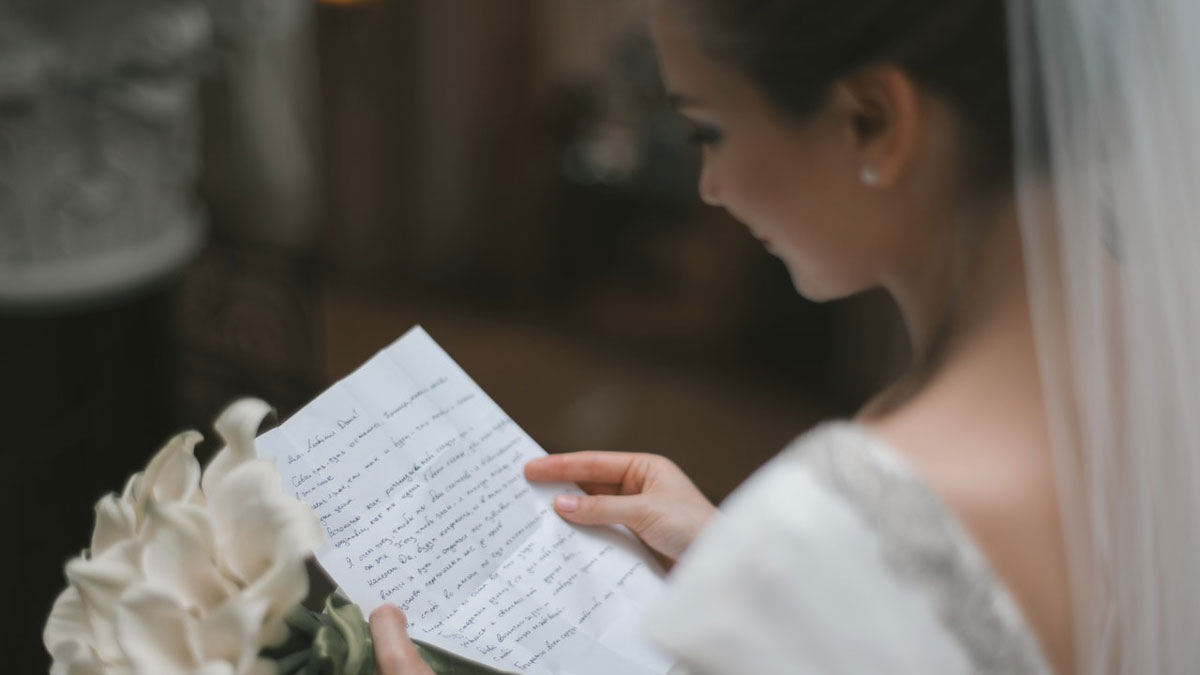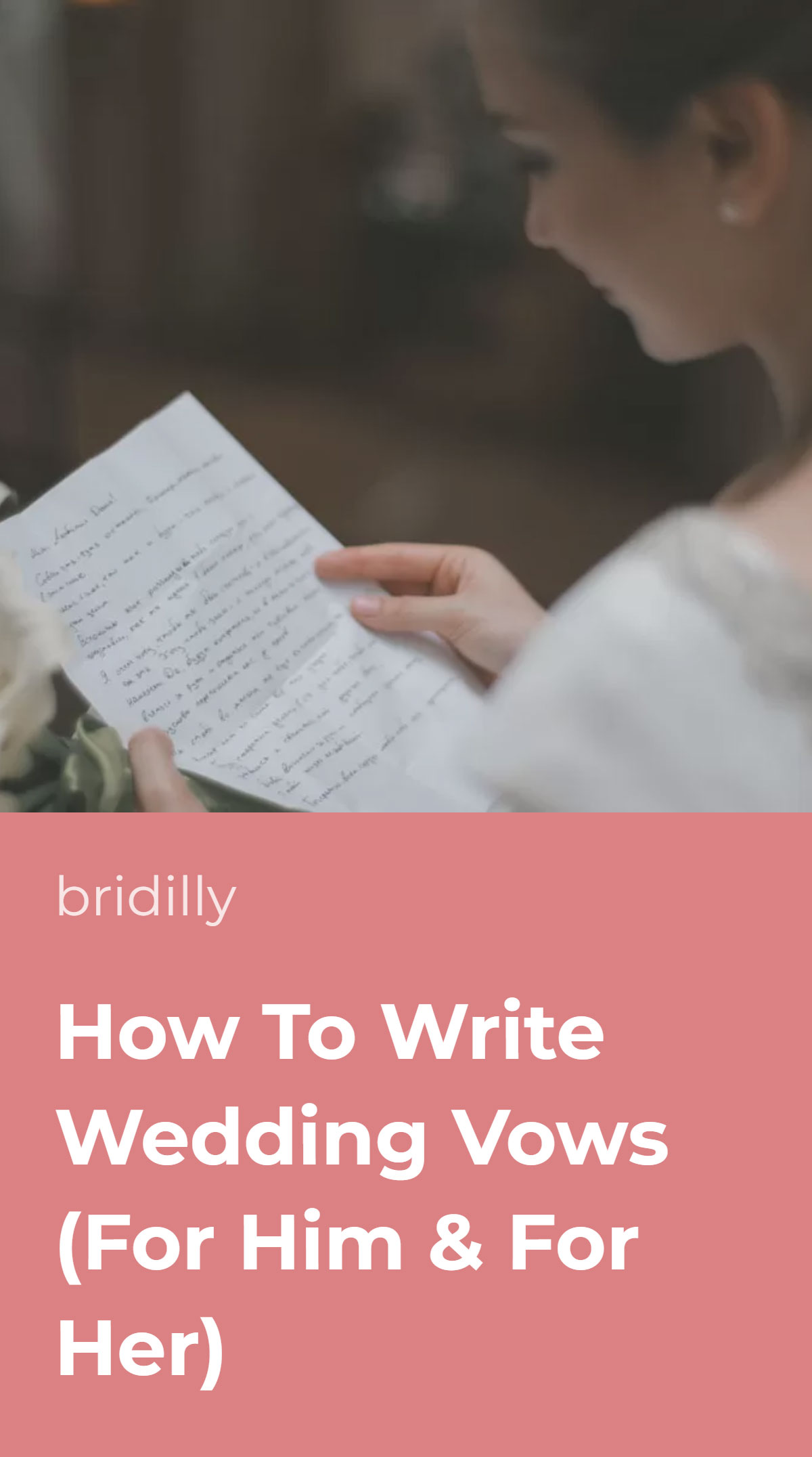At some point, every bride and groom wonders how to write wedding vows. Many are hesitant to start such a tremendous undertaking.
Summing up your feelings, dreams, memories, and promises in a short speech isn’t simple indeed.
Although writing vows may be overwhelming, it’s always worth the effort when you see your partner’s teary eyes in front of you at the ceremony.
The truth is that writing a vow isn’t that challenging once you define the preferred style, draw inspiration, gather memories, and learn the traditional structure.
Some people feel odd talking in front of the public and are afraid to sound dumb. In this case, consider a private vow exchange that has no limits in terms of appropriateness and won’t make you feel awkward.
Table of Contents [show]
Define Your Style
Before you begin writing your wedding vow, consider its style. Some vows are long and heartfelt; others are short and sweet or humorous.
Most importantly, your wedding vow style should match your personality and be appropriate for the location and event format.
For example, if you’re a lighthearted person and know your partner loves you for your humor, don’t hesitate to include a couple of funny lines in your speech. On the other hand, opt for a romantic vow if you’re sentimental.
Note that unconventional vows should still follow the traditional structure to some extent and include promises, even if your promise is not to watch the next episode of Friends without your partner.
Generally, short and funny vows are better for a courthouse wedding, whereas a church wedding requires a more formal tone. However, that’s merely a recommendation rather than a rule.
Consider The Length
Keeping in mind the wedding vow length is vital when you write one. The average wedding vow duration ranges from 45 seconds to two minutes, but some can wrap it up in 15 seconds, and others can talk for over five minutes.
The wedding vow duration depends on its style, ceremony time limit, and talking pace. Remember not to speak too slowly or too fast because the former may make your vow sound dull, and the latter will make you appear nervous.
Practice is key to finding the right wedding vow pace. Furthermore, you can ask someone to listen to your vow and advise on redundant lines.
Consulting with your wedding officiant regarding the vow length is a good idea. Of course, you’re the only one to decide how long your wedding vow will be, but your venue booking schedule may be tight, and you shouldn’t make other couples wait.
Don’t try to include your entire life story in your wedding vow. Although you’re reading it for your partner, remember about the guests. They may feel bored and straight-up awkward listening to a five-minute speech.
As a rule of thumb, a short vow is better than a long one. If you want to write very long vows, consider skipping them at the ceremony and exchanging them afterward in person.
Communicate With Your Partner
Communicate with your partner about the preferred vow style, duration, and any points they would like you to avoid before writing one. After all, you’re writing the vow for them, not for the guests or the priest.
Typically, couples prefer to stick with approximately the same vow length and similar style. The public may find it odd if one partner has a 30-second funny vow and the other a five-minute-long sentimental speech.
However, it’s all about coming to an agreement. There’s nothing wrong with different vow styles if both partners are ok with it. Perhaps, you love your significant other for their humor, and they love you for your sincerity.
Communicating about the vow style is also essential if you want to write an unconventional speech but are concerned about naysayers in your partner’s family.
Note that you don’t have to write your vows together unless you want to. Some couples work on their speeches together, but it may make your vow reading moment at the ceremony less emotional.
Draw Inspiration But Keep It Personal
Writing a wedding vow from scratch isn’t easy, even for professional copywriters. That’s understandable because words are often insufficient to express one’s admiration.
Some people are afraid of writing something dumb; others have a general fear of writing or don’t know how to start. Thankfully, you can draw inspiration online.
Research traditional, short and sweet, and funny wedding vow examples to define your favorite style and, perhaps, steal a couple of lines. Incorporating lines found online into your wedding vow isn’t wrong if you genuinely feel like it.
However, remember to keep your vow personal and unique. Don’t copy the entire speech from an online guide because each relationship is different and requires an individual approach. Note ideas you’ve found online and customize the lines.
Make a List & Gather Memories
Preparation is vital for writing a sincere and personal vow. Gather memories associated with your partner and write them down.
Think of how you met, your first date, when you understood that you were in love, how you met their friends and family, and other significant moments in your relationship. Avoid negative moments unless they are integral to positive memories.
Don’t filter the memories – let them flow and note each one, even if it seems dumb. Then, go through your list and pick the ones you find the most heartfelt, funny, or meaningful.
Physical items such as pictures, cards, souvenirs, and gifts are of great help in refreshing your memory. You can even bring the most symbolic items to the ceremony to remind your partner about special events.
Apart from memories, make a list of everything you love about your partner. It may be their personality traits, smile, or something special about their attitude towards you.
Additionally, write down how you view your relationship in the future, what you can do to improve it, what your partner has taught you, and any other impact they had on your life.
Vow Structure
There are no strict vow writing rules, but knowing the traditional vow structure can help you break the writing barrier. Feel free to customize the sections, change their order, or skip them altogether.
Start by setting the scene. Don’t overcomplicate it if you can’t come up with a creative beginning – simply address your partner by their name and explain how you feel at this exact moment.
Then, communicate your attitude towards your partner and explain why you love them. Describe what you admire about your relationship, what makes it unique, and what it has taught you.
After outlining your partner’s special traits and your attitude, you may share a short personal story relevant to your relationship in general or your wedding in particular.
Now, it’s time for the primary element of any vow – promises. In fact, that’s the only mandatory element that makes an ordinary speech an actual vow. You can write as many promises as you like, but most people stick with three to six.
After the promises, you may describe your vision of the future and your marriage and wrap it up with a loving last line.
How To Start
Writing will go easier once you start writing, we promise. But how do you start a wedding vow when you have so much and so little to say simultaneously?
Most people start their vows by addressing their partner by name – it may be a full name with the last name in a formal ceremony or a short name or nickname in a casual ceremony.
Then, you may add a conventional wedding vow starter, a universal phrase such as “You’ve taught me,” “I look forward to,” “The first time I saw you,” or “I realized I love you when.”
Your vow starter may lead straight to an explanation of what you love about your partner or a personal story, but many people prefer to first lay down how they feel standing at the end of the aisle.
For example, you may say something along the lines of “James, standing here with you today, I know that I’m where I am meant to be.”
Alternatively, you can choose a more creative and personal vow beginning that reflects your attitude towards life and your relationship.
How To End
When it comes to choosing the last wedding vow line, don’t overthink it. It doesn’t have to be the most memorable part of your vow, but it should wrap up everything you’ve told before.
Formal and romantic wedding vow ending examples include “I will forever be your person,” “You are my North star, my best friend, my forever,” and “To my soul mate, partner for life, and now my wife. I will always love you.”
However, some people prefer funny, personal endings such as “I love you like the musical Cats. Now and forever.”
Things To Avoid
The list of things to avoid in wedding vows is short, but you should remember each point when writing. Firstly, avoid gross words regardless of the context because they may take away the romance of the moment.
Furthermore, your wedding will likely be attended by kids and elders, who may find such words inappropriate. Secondly, never mention exes – that’s pretty self-explanatory.
Thirdly, don’t turn your vow into a stand-up, even if you choose a funny format. Remember what’s the reason you stand in front of your partner and stick with the 70/30 formal speech to joke ratio.
Lastly, don’t embarrass your partner in any way. Don’t talk about their weaknesses, odd habits, sex, your divorce, or highly detailed stories appropriate for friends but not for family.













No Comments Add one
Leave a Comment